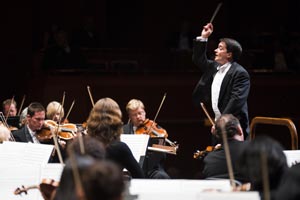Critiques
13 - 16 janvier 2011
The first piece ends with a flourish. From here it’s not too difficult to believe Conductor Jacques Lacombe when he says man and the music he makes has been forever influenced and inspired by water. After simple consideration it’s all so clear. Intentional or not, the comparisons are obvious. The way music develops slow, languishing textures like a still pond or violent crescendos like waves crashing on a beach, it’s a perfect fit. The bows of two-dozen violinists glide up and down over their instrument strings, all of them uniform, like ripples over water. It’s something more than interpretation.
Edward Van Embden, Red Bank Shrewsbury Patch
18 janvier 2012Continuing with Handel’s iconic “Water Music,” Lacombe explained that he would be changing the configuration of the orchestra to give us more of the experience King George I may have had with his royal guests on one barge, while the musicians played on another. At different points, the barges would be close, and the musicians would play the more subtle movements, and when farther apart, would play the louder ones. The Maestro set the French Horns on audience left and the trumpet and piccolo trumpet to the right. In an unwitting battle of the sexes—women on French horns, men on trumpets—we had a delightful call and response, then the orchestra jumping into the mix–pure delight!
Sherri Rase, Q onStage
janvier 2012
